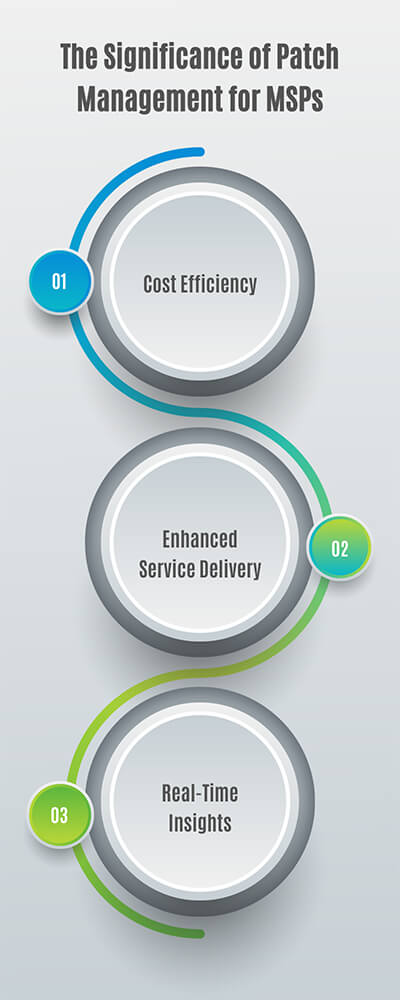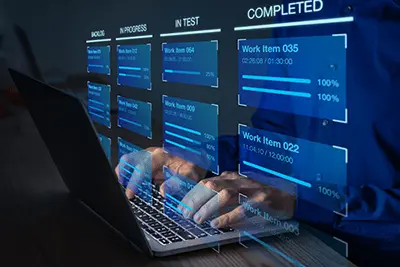The Significance of Patch Management for MSPs
Cost Efficiency:
Traditional patch management solutions often incur steep license fees, burdening MSPs financially. However, at ITarian, we prioritize cost efficiency. Our patch management solution offers a free-of-charge option, alleviating MSPs from the financial strain of licensing expenses. This cost-effective approach enables MSPs to redirect resources toward enhancing other aspects of their operations, ultimately reducing costs and increasing profitability.
Enhanced Service Delivery:
In the competitive realm of MSP services, delivering exceptional quality is paramount for client satisfaction and business growth. Our patch management systems automate routine tasks, empowering MSPs to boost service delivery without expanding their workforce. This streamlining allows MSPs to efficiently manage a more extensive client portfolio while maintaining or even enhancing service quality.
Real-Time Insights:
Real-time insights are crucial for proactive management in today's fast-paced digital environment. Our patch management product offers real-time charts and statistics, providing MSPs with up-to-the-minute visibility into their clients' IT environments. This real-time data empowers MSPs to swiftly identify and address potential issues, reducing downtime and enhancing overall system reliability.

What's the Difference between Patching and Updating?
Understanding the distinction between patching and updating is essential for effective IT management. While both processes involve modifying software, they serve different purposes in maintaining the health and security of your digital environment.
Patching:
- Definition: Patching refers to applying specific modifications or "patches" to existing software, typically to address security vulnerabilities, bugs, or errors.
- Definition: Patching refers to applying specific modifications or "patches" to existing software, typically to address security vulnerabilities, bugs, or errors.
- Purpose: Patching primarily focuses on improving security by fixing known vulnerabilities that cybercriminals could exploit. It also addresses software glitches that may cause operational issues.
- Frequency: Patches are released as needed in response to newly discovered vulnerabilities or issues. They are not typically scheduled updates.
- Examples: Security patches, bug fixes, hotfixes, and critical updates are typical patches.
Updating:
- Definition: Updating involves making broader changes to software to add new features, enhance functionality, or improve overall performance.
- Purpose: Updating aims to enhance software capabilities, introduce new features, and ensure it operates optimally. It may also include security enhancements, but security is not the primary focus.
- Frequency: Updates are generally scheduled and planned. They may follow a regular release cycle, such as monthly or quarterly updates.
- Examples: Major version upgrades, feature updates, and service packs are typical updates.
Key Differences:
- Focus: Patching primarily focuses on security and bug fixes, whereas updating is more comprehensive and includes feature enhancements.
- Frequency: Patching is often done as needed and in response to specific issues, while updating follows a scheduled release cycle.
- Purpose: The primary purpose of patching is security while updating aims to enhance functionality and performance.
- Examples: Patches include security updates and bug fixes, while updates encompass significant version changes and feature additions.
Understanding the difference between patching and updating is crucial for making informed decisions about managing your software and ensuring the security and efficiency of your IT environment.
Crafting a Client Acquisition Strategy
Client acquisition is the cornerstone of growth and success for MSPs. The ability to attract and retain clients directly influences an MSP's revenue, reputation, and long-term sustainability. In a competitive landscape, distinguishing your MSP business and building a loyal client base is paramount.
The Power of Free Services:
At ITarian, we understand that offering free patch management services can be a game-changer for MSPs. Here's why:
Creating Goodwill:
Offering free services is a powerful way to establish goodwill with potential clients. It showcases your commitment to their success and security, even before they've committed to your paid offerings. This initial act of generosity lays a solid foundation for trust and collaboration.
Positioning as Cost-Effective:
You position your MSP business as a cost-effective solution provider by providing free patch management services. Clients appreciate cost savings, and this perception of affordability can be a crucial differentiator in a competitive market.
Client-Centric Approach:
Free services underscore your client-centric approach. It sends a message that you prioritize client needs and value their business. This client-focused mindset can attract and retain clients looking for a partner rather than just a service provider.
Driving Profitability Through Free Services:
The strategic deployment of free patch management services goes beyond altruism; it's a potent driver of profitability:
- Upselling Opportunities: Clients who initially opt for free patch management services are more likely to recognize the value of your comprehensive MSP offerings as they experience the benefits firsthand. This sets the stage for upselling and cross-selling opportunities. As clients grow and their needs evolve, you can seamlessly transition them to paid versions of your services, increasing your revenue.
- Enhancing Client Loyalty: Clients who receive valuable services for free are more likely to stay loyal when they upgrade to paid plans. They've already experienced your reliability, and this positive history fosters loyalty. Long-term client relationships ensure a steady stream of revenue and reduce client churn, which can be costly for MSPs.
- Word-of-Mouth Marketing: Satisfied clients are often vocal advocates for your MSP business. They become enthusiastic advocates when they've benefited from your free services and then see the value in your paid offerings. Positive word-of-mouth referrals can drive new client acquisitions without significant marketing expenses.
MSP Patch Management FAQ
A: MSP Patch Management identifies, deploys, and maintains software updates or patches on clients' systems to enhance security and performance. It's crucial for MSPs because it helps prevent security vulnerabilities, reduce downtime, and improve overall IT system health for their clients. Proper patch management ensures that software is up to date, reducing the risk of cyberattacks and data breaches.
A: ITarian offers a free patch management solution that empowers MSPs in several ways:
- Cost Savings: The free option eliminates the need for license fees, reducing operational costs.
- Enhanced Service Quality: Automation simplifies routine tasks, allowing MSPs to focus on delivering top-quality services.
- Real-Time Insights: ITarian's solution provides real-time charts and statistics, enabling MSPs to manage client environments proactively.
A: Transitioning clients from free patch management to paid services can be seamless:
- Begin by identifying clients whose needs have evolved or require additional assistance.
- Schedule a consultation to discuss their changing needs and how your paid services can address them effectively.
- Develop a customized service plan tailored to their requirements and budget.
- Provide clear communication and support during the transition to ensure a smooth experience.
- Monitor client satisfaction and gather feedback to refine and optimize your services continually.
A: Patching and updating can occur on the same software or system. It's common for updates to include patches. Updates often include security patches, bug fixes, and new features and improvements. This ensures your software remains secure and up-to-date while benefiting from enhanced functionality.
A: The frequency of patching and updating depends on several factors, including the software in use and your organization's policies. Generally, security patches should be applied as soon as they are released to mitigate vulnerabilities. Updates, on the other hand, can follow a predetermined schedule, such as monthly or quarterly, or be based on the release cycle of the software. Regularly reviewing and assessing the urgency of patches and updates is crucial for effective management.
A: Failing to patch and update software can expose your systems to various risks. Without security patches, cybercriminals may exploit vulnerabilities, leading to data breaches, malware infections, and other security incidents. Not updating software can result in missed opportunities for performance improvements and new features, potentially impacting productivity and efficiency. Additionally, it may lead to compatibility issues with other software or systems. Regular patching and updating are essential to mitigate these risks and maintain a secure and functional IT environment.
